Your cart is currently empty!
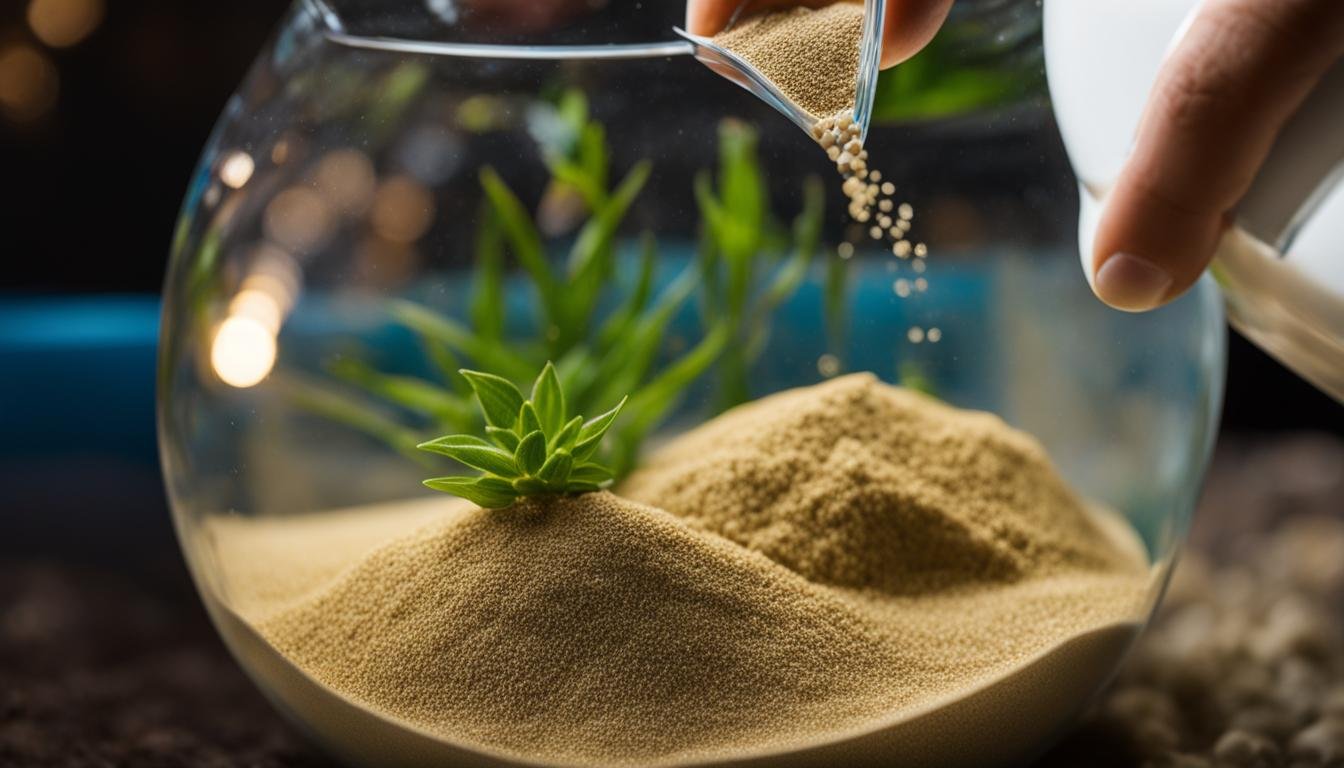
How Do You Add Sand To An Existing Aquarium?
Greetings, aquarium enthusiasts! Adding sand to an existing aquarium is a straightforward process that can enhance the beauty and functionality of your tank. Whether you’re aiming for a natural look or providing a comfortable habitat for your fish, properly adding sand to your aquarium is essential.
Here at [Your Website Name], we understand the importance of creating a thriving aquatic environment. That’s why we’ve put together this guide to help you successfully add sand to your existing aquarium and create a stunning underwater landscape for your aquatic friends.
Key Takeaways:
- Adding sand to an existing aquarium can transform the overall look and feel of your tank.
- Proper preparation and rinsing of the sand are crucial for a successful addition.
- Ensure you have all the necessary supplies before starting the process.
- Follow a step-by-step process to transfer fish, add the sand, and make the tank safe for your aquatic friends.
- Introducing your fish to the new sand substrate can be an exciting and rewarding experience.
Ready to dive into the details? Let’s explore the tips and techniques for adding sand to your existing aquarium!
Tips for a Successful Addition of Sand
Adding sand to your existing aquarium can greatly enhance the aesthetic appeal and provide numerous benefits for your aquarium inhabitants. However, it’s important to follow some essential tips to ensure a successful addition of sand. Here are some key things to keep in mind:
1. Prepare the tank
- Before adding sand, make sure to remove any decorations, rocks, or plants that may interfere with the process.
- Consider adding a protective layer such as a mesh or fine netting to prevent the sand from settling underneath rocks or decorations.
- Ensure the tank is properly cleaned and free from debris before adding the sand. This will help maintain water quality and prevent any unwanted substances from accumulating.
2. Choose the right sand bed
When selecting sand for your aquarium, consider the specific requirements of your fish and other aquatic creatures. There are different types of aquarium sand available, such as fine sand, coarse sand, and live sand. Research the needs of your fish species to determine the most suitable sand bed for their well-being.
3. Gradually add the sand
It’s best to add the sand slowly and in small amounts to ensure an even distribution. Pouring the sand too quickly can disturb the water and create cloudiness. Using a gentle stream or pouring it over a plate or mesh can help achieve a more controlled and gradual addition.
4. Monitor and maintain water parameters
- Keep a close eye on your tank’s water parameters, such as pH, ammonia, nitrate, and nitrite levels, after adding sand. These parameters should be regularly checked and maintained at appropriate levels to ensure a healthy environment for your aquatic pets.
- Perform regular water changes to remove any excess debris or particles that may accumulate in the sand bed over time.
By following these tips, you can successfully add sand to your existing aquarium and create a visually stunning and healthy habitat for your fish and other aquatic creatures.
Proper Process for Adding Sand to an Existing Tank
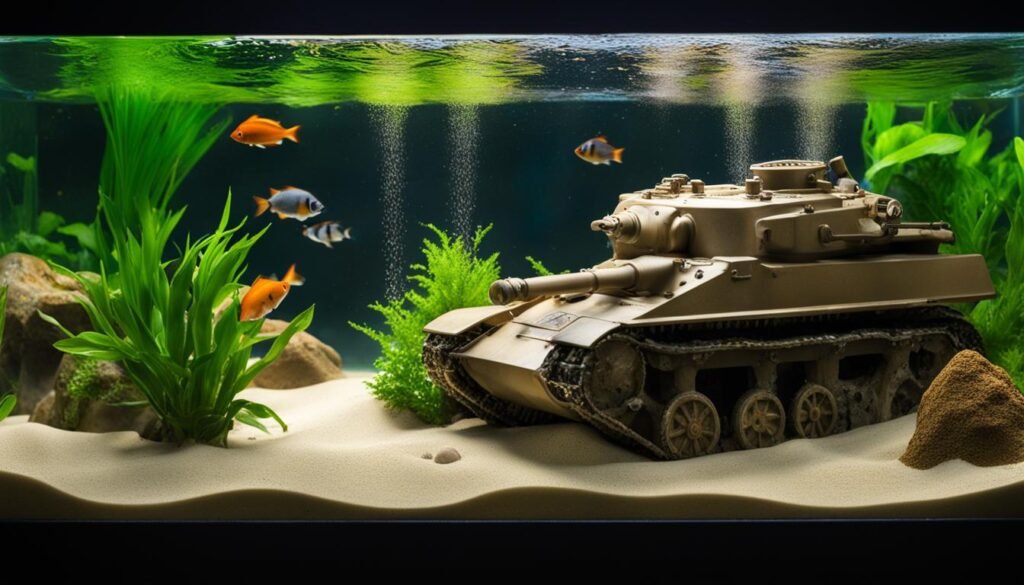
When it comes to adding sand to an existing aquarium, following a proper process is key to achieving optimal results. By taking the necessary steps, you can ensure that your sand setup is installed correctly and provides various benefits for your aquarium and its inhabitants.
Here is a step-by-step guide to help you navigate the process of adding sand to your existing tank:
Gather the necessary supplies
- Aquarium sand: Choose a sand substrate that is suitable for your aquarium setup.
- Bucket: Use a clean bucket to rinse and prepare the sand.
- Aquarium vacuum: This tool will help you clean any debris or leftover particles from the substrate.
- Net: You’ll need a net to transfer your fish safely during the process.
- Aquarium water conditioner: Use a water conditioner to remove any chlorine or harmful chemicals from the water.
Prepare and rinse the sand
- Before adding the sand to your tank, rinse it thoroughly to remove any dust, debris, or impurities. Use a clean bucket and fill it with the sand.
- Add water to the bucket and stir the sand vigorously. This will help to loosen any particles and make it easier to rinse.
- Drain the water and repeat the rinsing process until the water runs clear. This step is crucial to prevent cloudiness in your tank.
Transfer fish and add the sand to the tank
- Use a net to gently transfer your fish to a separate container filled with tank water. This will keep them safe and secure during the sand addition process.
- Slowly pour the rinsed sand into the tank, distributing it evenly across the bottom. Be careful not to disturb any existing plants, decorations, or other tank inhabitants.
- Once the sand is added, carefully fill the tank with water. Use a plate or saucer to disperse the water flow and minimize disturbance to the sand bed.
Make the tank safe for fish
After adding the sand and water, it’s important to make the tank safe for your fish:
- Monitor the water parameters, such as temperature, pH, and ammonia levels, to ensure they are suitable for your fish.
- Observe your fish for any signs of stress or discomfort. If necessary, provide hiding places or additional plants to create a sense of security.
- Perform regular water tests and maintenance to keep the tank clean and the sand bed healthy.
By following this proper process for adding sand to your existing tank, you can create a visually pleasing and beneficial environment for your aquarium and its inhabitants.
Pros and Cons of Using Sand in an Aquarium
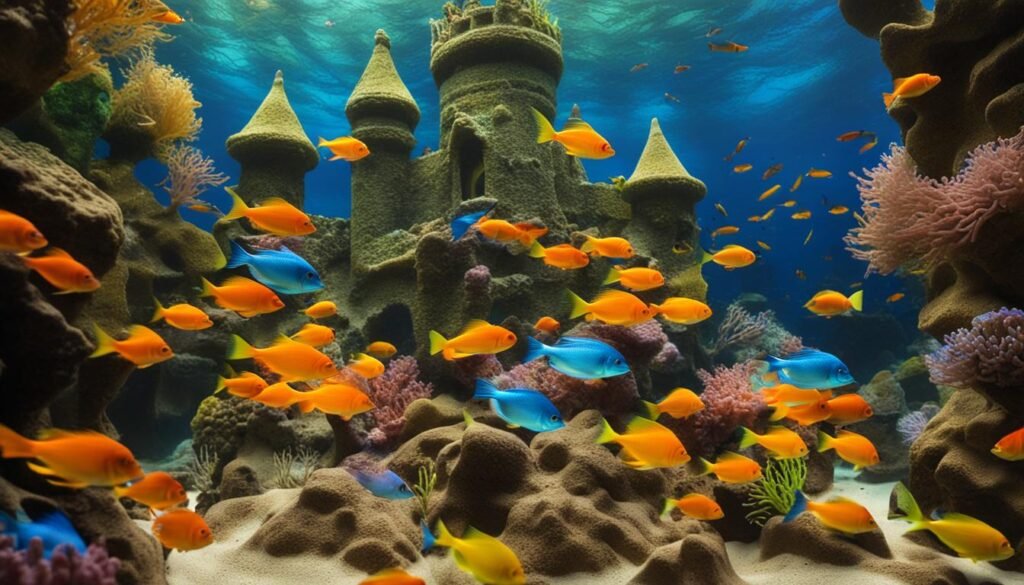
Using sand as a substrate in an aquarium offers several benefits and drawbacks that every aquarium owner should consider. Let’s explore the pros and cons of using sand as an aquarium substrate:
Pros
- Enhanced Aesthetics: Sand provides a natural and visually appealing look to your aquarium, mimicking the environment of rivers and beaches.
- Beneficial for Bottom-Dwelling Fish: Sand is gentle on the sensitive bellies of bottom-dwelling fish, preventing abrasions and injuries.
- Promotes Natural Behavior: Sand substrate encourages natural digging and foraging behavior in many fish species, promoting their overall well-being.
- Safe for Plant Growth: Live plants root well in sand, ensuring a healthy and thriving aquatic environment.
Cons
- Silt Accumulation: Compared to other substrates, sand tends to trap more silt and debris, requiring regular maintenance to keep the tank clean.
- Reduced Water Flow: Fine sand particles may impede water flow in the aquarium, making it harder to maintain a healthy ecosystem.
- Limited Plant Nutrition: While sand is suitable for plant growth, it may lack essential nutrients, requiring supplemental fertilizers for optimal plant health.
- Challenging Cleanup: If accidentally disturbed, sand can cloud the water and disrupt the clarity of the aquarium, necessitating a thorough cleanup.
Consider these pros and cons when deciding whether to use sand as substrate for your aquarium. The choice depends on your personal preferences, the type of fish and plants in your tank, and your willingness to perform regular maintenance.
Gathering Supplies for Adding Sand to the Tank
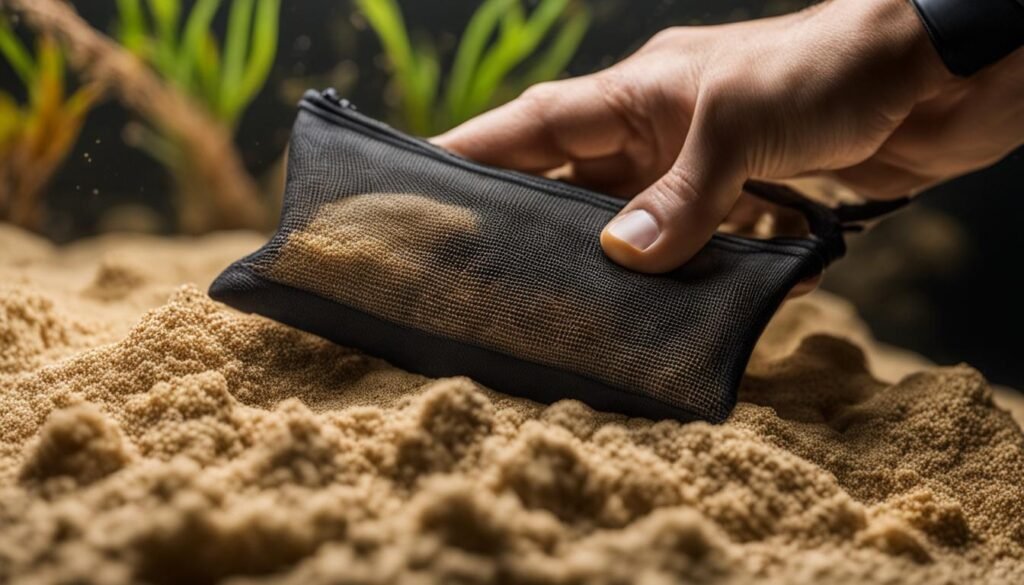
When it comes to adding sand to your aquarium, it’s important to gather all the necessary supplies beforehand. This ensures that you have everything you need and makes the process smoother. Here are the essential supplies you’ll need for adding sand to your tank:
Aquarium Sand:
Choose a high-quality aquarium sand that is suitable for your specific setup. There are different types of sand available, such as fine sand or coarse sand, depending on your preference and the type of fish you have. Make sure to measure the amount of sand you’ll need based on the size of your tank.
Bucket:
A clean bucket will be useful for rinsing and preparing the sand before adding it to the tank. It’s important to use a bucket that is designated for aquarium use only, as any residue from cleaning products could be harmful to your fish.
Siphon or Gravel Vacuum:
A siphon or gravel vacuum is handy for removing any debris or detritus from the existing sand bed before adding new sand. This helps to maintain a clean and healthy environment for your fish.
Net or Container:
You’ll need a net or container to safely transfer your fish to a temporary holding area while you add the sand to the aquarium. This prevents them from getting stressed or injured during the process.
Clean Water:
Having clean, dechlorinated water ready for the tank is essential. You’ll need this water to rinse the sand and fill the tank once the sand is added. Make sure to treat the water with a suitable conditioner to remove any chlorine or other harmful chemicals.
Optional: Decorations and Plants:
If you wish to add decorations or live plants to your tank, gather them beforehand. This allows you to plan the placement and make adjustments as needed before the sand is added.
Gathering these supplies ahead of time will make the process of adding sand to your tank much easier and more efficient. Taking the time to prepare ensures that you have everything you need to create a beautiful and comfortable environment for your fish.
Preparing and Rinsing the Sand
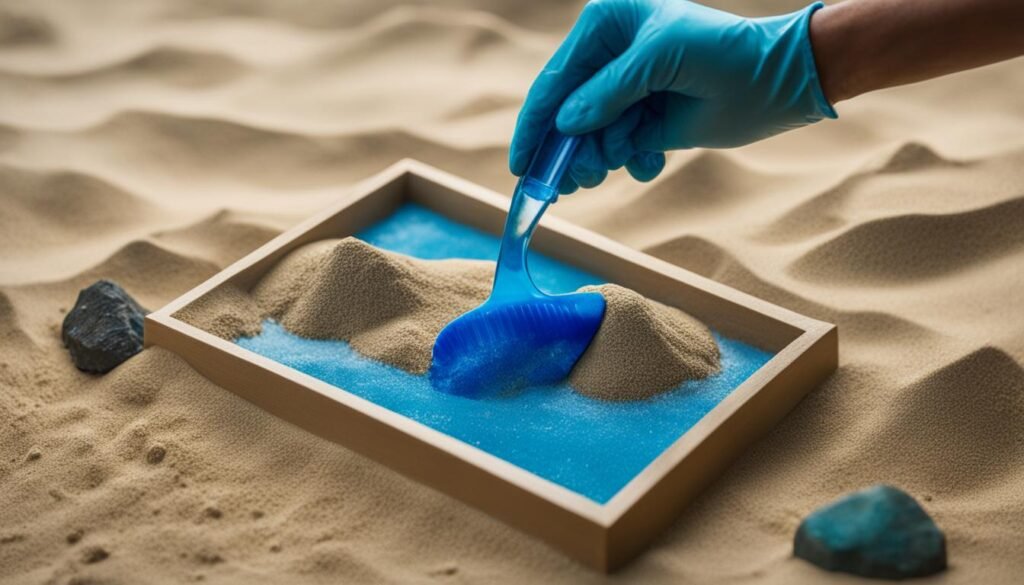
Before adding the sand to your aquarium, it’s important to properly prepare and rinse it. This helps remove any impurities or debris that may be present, ensuring a clean and safe environment for your fish. Follow these steps to prepare and rinse the sand:
Gather the Necessary Tools
Before you begin, gather the necessary tools for rinsing the sand. You will need a clean bucket, a hose or faucet with a strong flow of water, and a sieve or colander.
Rinse the Sand
- Start by placing a small amount of sand into the sieve or colander.
- Hold the sieve or colander under the faucet or hose, allowing the water to flow through and rinse the sand thoroughly. Move the sand around with your hand to ensure all sides are rinsed.
- Continue rinsing the sand in small batches until all the sand has been rinsed.
- Once rinsed, transfer the clean sand into the clean bucket.
Repeat the Rinsing Process
It’s important to repeat the rinsing process several times to ensure all impurities are removed from the sand. Repeat the steps above until the water runs clear when rinsing the sand.
By properly preparing and rinsing the sand, you can ensure a clean and safe substrate for your aquarium. This helps create a healthy environment for your fish and promotes their overall well-being.
Transferring Fish and Adding the Sand to the Tank
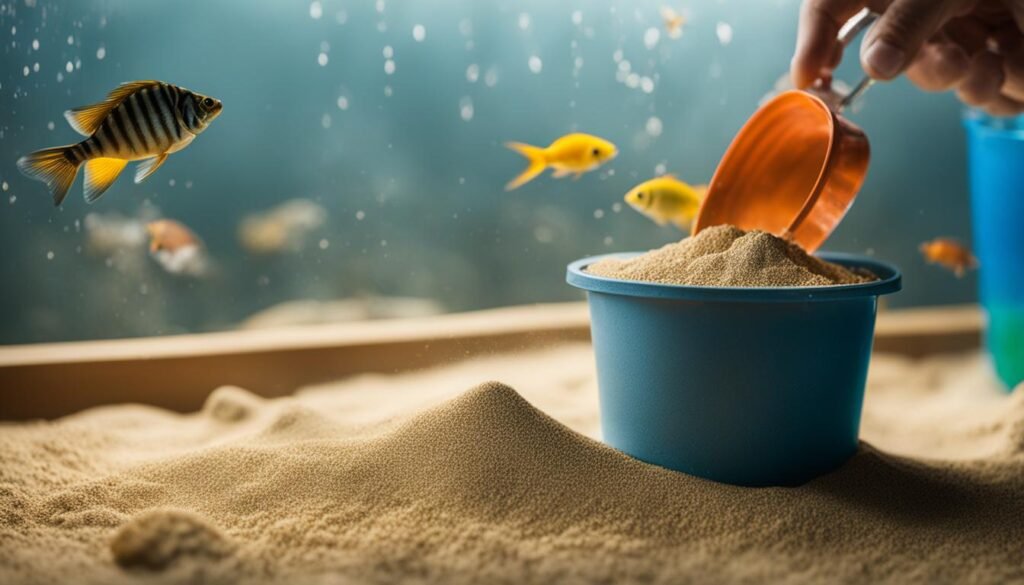
Now that you have prepared and rinsed the sand, it’s time to transfer your fish and add the sand to the tank. Follow these steps to ensure a smooth process:
Step 1: Prepare a Temporary Home
Before transferring the fish, it’s important to have a temporary home ready for them. This can be a separate aquarium or a clean container filled with treated water from their original tank. Make sure the temporary home is equipped with a heater and filter to maintain a comfortable environment for your fish.
Step 2: Catch and Transfer the Fish
Using a fish net, carefully catch each fish from the original tank and transfer them to the temporary home. Take your time and be gentle to avoid stressing or injuring the fish. Once all the fish are safely transferred, cover the temporary home to prevent any escapes.
Step 3: Add the Sand to the Tank
With the fish safely in their temporary home, you can now add the sand to the tank. Slowly pour the prepared sand into the tank, being careful not to disturb the water too much. Gradually spread the sand across the bottom of the tank, creating an even layer. Take your time to achieve the desired depth and coverage.
Step 4: Monitor and Reintroduce the Fish
Once the sand is added, carefully monitor the tank water to ensure it remains clear and free of any debris. Allow the filter to run for a few hours to help settle the sand. After a few hours, you can reintroduce your fish to their newly decorated tank. Slowly acclimate them to the tank water temperature and carefully release them into their new environment. Keep a close eye on their behavior and make sure they adjust well to the sand substrate.
By following these steps, you can safely transfer your fish and add the sand to your aquarium. Remember to be patient and gentle throughout the process to minimize stress on your fish. Now that the sand is in the tank, it’s time to move on to making the tank safe for your fish.
Making the Tank Safe for Fish
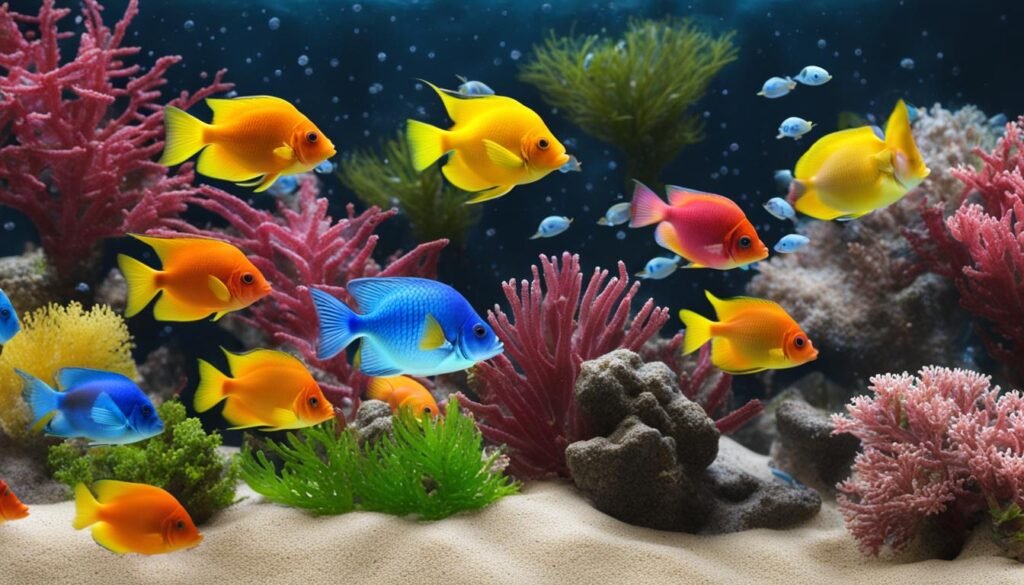
Once the sand has been successfully added to your aquarium, it’s crucial to take the necessary steps to ensure the tank is safe for your fish. This will help create a healthy and thriving environment for them to live in. Here are some important considerations to keep in mind:
1. Monitor Water Parameters
After adding the sand, carefully monitor the water parameters to ensure they are within the appropriate range for your fish species. This includes checking the temperature, pH levels, and ammonia, nitrite, and nitrate levels. This will help you identify any potential issues and take corrective measures if needed.
2. Cycle the Tank
If you have introduced new sand to your aquarium, you may need to cycle the tank to establish a stable nitrogen cycle. This process helps establish beneficial bacteria in the tank that will break down harmful waste products. Regular water testing and partial water changes will be necessary during this phase.
3. Maintain Proper Filtration
Ensuring adequate filtration is crucial for maintaining water quality. Make sure your aquarium filter is properly sized for your tank and running efficiently. Regularly clean or replace filter media as recommended by the manufacturer to prevent debris buildup and maintain optimal water flow.
4. Observe Fish Behavior
Pay close attention to your fish’s behavior after adding the sand. If you notice any signs of stress, such as unusual swimming patterns or loss of appetite, it may indicate a problem with the tank’s environment. Take immediate action to address the issue and seek advice from a qualified aquatic professional if necessary.
By taking these steps to make the tank safe for your fish, you can ensure their well-being and create a thriving aquatic environment. Remember to regularly monitor water parameters, cycle the tank if necessary, maintain proper filtration, and observe your fish’s behavior. With patience and care, your fish will enjoy their new sand substrate aquarium.
Introducing Fish to the New Sand Substrate Aquarium

Now that you have successfully added sand to your aquarium and set up the tank, it’s time to introduce your fish to their new sandy substrate. Here are some important steps to help you ensure a smooth transition for your fish:
1. Acclimate your fish
Before adding your fish to the tank, it’s crucial to acclimate them properly. This involves gradually adjusting the temperature and chemistry of the water in their transport bag to match that of the tank. This helps to minimize stress and prevent any sudden changes that could harm your fish. Follow a proper acclimation process to give your fish the best chance of adapting to their new environment.
2. Monitor water parameters
After introducing your fish to the tank, it’s important to monitor the water parameters regularly. Keep an eye on the temperature, pH level, ammonia, nitrite, and nitrate levels. Any sudden changes could indicate an issue with the sand or the overall tank environment. Be vigilant and address any problems promptly to ensure the health and well-being of your fish.
3. Observe fish behavior
Once your fish are in the new sand substrate aquarium, observe their behavior closely. Watch for any signs of stress, aggression, or illness. If you notice any abnormal behavior, it’s important to investigate and take appropriate action. Remember that transitioning to a new substrate can sometimes disrupt the established hierarchy among fish, so be prepared for potential territorial disputes and closely monitor the situation.
By following these steps, you can ensure a smooth introduction of your fish to their new sand substrate aquarium. Remember to acclimate your fish properly, monitor water parameters, and observe fish behavior closely. Creating a comfortable and stress-free environment for your fish will help them thrive in their new sandy home.
Conclusion
Adding sand to an existing aquarium can be a rewarding experience for us aquarium enthusiasts. By following the steps outlined in this guide, we can successfully introduce sand to our tanks and create a natural and vibrant environment for our fish.
Remember, proper aquarium maintenance is crucial to keep our fish happy and healthy. Regularly cleaning and maintaining the sand bed will help prevent any build-up of waste and ensure optimal conditions for our aquatic friends.
So, whether we’re looking to enhance the aesthetics of our aquarium or provide a more suitable substrate for certain fish species, adding sand can be a great choice. Just make sure to have a solid plan, rinse the sand thoroughly, avoid disturbing the existing sand bed, and take necessary steps to make the tank safe for our fish.
By following these guidelines, we can enjoy the benefits of a beautiful sand substrate in our aquariums and provide a comfortable home for our aquatic companions.
FAQ
How do you add sand to an existing aquarium?
To add sand to an existing aquarium, follow these steps:
What are some tips for a successful addition of sand?
To ensure a successful addition of sand, consider the following tips:
What is the proper process for adding sand to an existing tank?
When adding sand to an existing tank, it’s important to follow these steps:
What are the pros and cons of using sand in an aquarium?
Using sand as a substrate in an aquarium has its advantages and disadvantages:
What supplies do I need for adding sand to the tank?
Before adding sand to your tank, gather the following supplies:
How do I prepare and rinse the sand before adding it to the tank?
To prepare and rinse the sand, follow these steps:
How do I transfer fish and add the sand to the tank?
When adding sand to the tank, follow these steps to transfer fish and add the sand:
How do I make the tank safe for fish after adding the sand?
After adding the sand and water, it’s important to make the tank safe for your fish:
How do I introduce fish to the new sand substrate aquarium?
Follow these steps to introduce your fish to the new sand substrate aquarium:
What are the key takeaways when adding sand to an existing aquarium?
Adding sand to an existing aquarium can be a rewarding experience when done properly. Remember to have a plan, rinse the sand, avoid disturbing the existing sand bed, and make the tank safe for your fish.
Leave a Reply